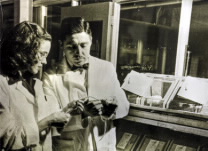FOR IMMEDIATE RELEASE | April 29, 2010
Chemical Society names Elkhart invention National Landmark; U.S. Rep. Donnelly to attend
WASHINGTON, April 29, 2010 –– A home-testing method developed in Elkhart, Ind., by scientists at Miles Laboratories, now Bayer HealthCare LLC, forever transformed the lives of people with diabetes and kidney disease. Dip-and-read diagnostic strips will be designated a National Historic Chemical Landmark by the American Chemical Society (ACS) on May 1, 2010.
“The work of Alfred and Helen Free in developing dip-and-read diagnostic strips was a major biochemical advance,” ACS Board of Directors Chair Bonnie Charpentier said. “The work of the Frees and other researchers at Miles Laboratories gave doctors and patients the tools to easily and inexpensively monitor diabetes and kidney diseases. Their research and the subsequent development of Clinistix® demonstrate how the transforming power of chemistry can improve people’s lives.”
To honor the Frees’ work, Charpentier will present a plaque on behalf of ACS during a ceremony that will be held at ETHOS, Inc., a science museum in Elkhart, Ind., beginning at 1 p.m., Saturday, May 1. U.S. Rep. Joe Donnelly (D-IN) will attend and offer remarks on this landmark research as will Elkhart General Hospital representatives, Mayor Dick Moore, and others.
“On behalf of the Free family, I would like to thank the Board of Directors of the American Chemical Society,” Helen Free said. “It is indeed an honor for Miles Laboratories and Clinistix® to be chosen as a National Historic Chemical Landmark. Al and I, and the team, at the time were thinking ‘What can we do new for the future?’ Recently, I was in Austin, Texas, and spoke with a woman. She said her husband was a diabetic and if we hadn’t done this he wouldn’t be alive today. We all cried. It was a wonderful outreach moment.”
“Bayer is honored that the ACS has conferred landmark status to the Development of Diagnostic Test Strips,” said Rick Stadterman, vice president, Global R&D, Bayer Diabetes Care. “Over 50 years ago, chemists at Bayer’s former Miles division invented the first dip-and-read strips, allowing patients to easily monitor their glucose levels at home and become more involved in diabetes self care. Today, Bayer R&D continues to explore next generation sensor technology to benefit patients with diabetes. The contributions of research chemists to this effort are essential to Bayer Diabetes Care’s ongoing mission: ‘To simplify the lives of people with diabetes empowering them to take charge of their health and happiness.’ Thank you for this honor.”
Following the ceremony, ETHOS staff will also offer hands-on activities using simulated blood and urine samples where kids of all ages will have a chance to perform chemical diagnostic tests on fictional characters. The museum will also showcase a history of diagnostic tools, a diabetes timeline, and offer interesting videos. The kids’ activities will begin at 2 p.m.
Prior to 1956, when the Frees invented dip-and-read diagnostic tests, urine and blood tests that are now considered routine required laboratory equipment and expertise, which made it impossible to closely monitor a person’s blood sugar levels. The Frees, research chemists at Miles Laboratories, wondered if there was a better way to do the tests — one that didn’t involve Bunsen burners, test tubes, and was more convenient than effervescent tablets. The Frees’ team developed a way to impregnate reagents directly onto slim strips of filter paper that when dipped into a urine sample changed color to indicate the level of glucose present. The result was Clinistix® — a simple, no-mess, highly accurate means of testing urine samples. For diabetics the new invention had the added benefit of testing specifically for glucose rather than for sugars in general.
With the advent of dip-and-read diagnostic strips, people with diabetes and kidney disease gained a previously unimaginable degree of control over their health thanks to the convenience of greatly simplified testing. Scientists subsequently developed similar dip-and-read tests including Albustix® for protein, and Multistix®, which permitted 10 different clinical tests on a single strip.
ACS designates as National Historic Chemical Landmarks those seminal chemistry inventions, discoveries, and research that fundamentally improve peoples’ lives. Since the program’s inception in 1992, ACS has designated 66 Landmarks (including dip-and-read diagnostic tests). Other landmarks include the discovery of penicillin, the development of Tide (the first synthetic laundry detergent), the historic research of Joseph Priestley, who identified oxygen, and the agricultural research of George Washington Carver, among others. For more on the Landmarks program, please visit www.acs.org/landmarks.
###
About the participants:
ETHOS (Encouraging Technology and Hands On Science) was created by Bayer HealthCare LLC to further community outreach. A non-profit, ETHOS provides research developed curriculum management and assists teachers in the areas of science education. It also offers a host of science activities for the community, such as science summer camps and field trips.
Bayer Diabetes Care is a worldwide leader in diabetes care, supporting customers in 100 countries and, for more than 40 years, has led the way in diabetes care product innovation. Today, Bayer Diabetes Care offers an unparalleled choice in diabetes management systems and comprehensive support including education, tools and resources designed to simplify life with diabetes. Bayer Diabetes Care is a business of the Bayer HealthCare LLC, Medical Care Division and has its global headquarters located in Tarrytown, N.Y. www.simplewins.com
Bayer HealthCare The Bayer Group is a global enterprise with core competencies in the fields of health care, nutrition and high-tech materials. Bayer HealthCare, a subsidiary of Bayer AG, is one of the world’s leading, innovative companies in the healthcare and medical products industry and is based in Leverkusen, Germany. The company combines the global activities of the Animal Health, Consumer Care, Medical Care and Pharmaceuticals divisions. The pharmaceuticals business operates under the name Bayer Schering Pharma. Bayer HealthCare’s aim is to discover and manufacture products that will improve human and animal health worldwide. Find more information at www.bayerhealthcare.com.


